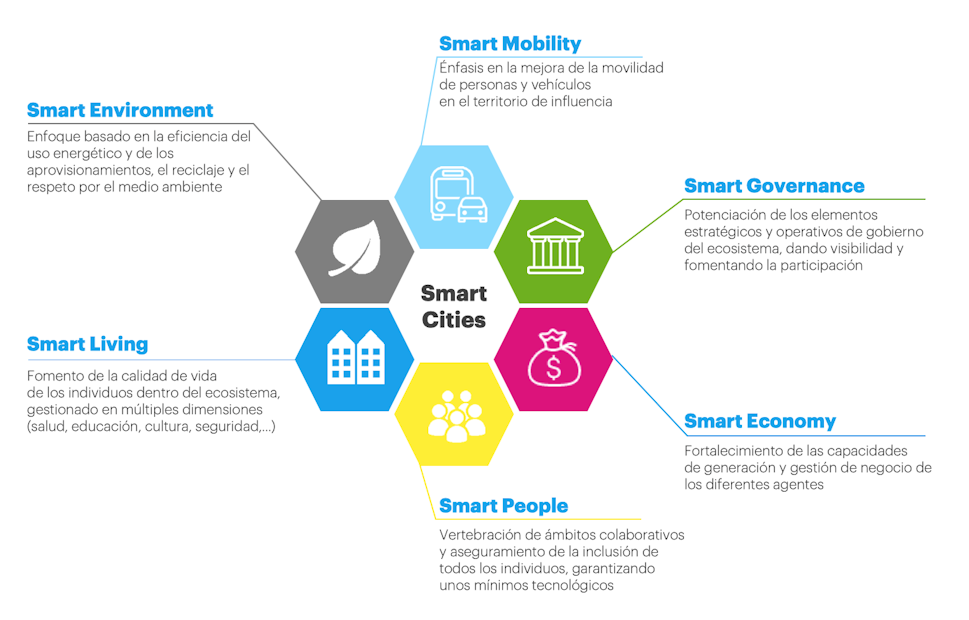Study case
The benefits and key success factors of a strategic plan for smart cities

Cities have evolved to play a fundamental role in socioeconomic development because of their population density
The importance that cities have gained in recent years has transformed them into society’s major sustainability challenges. As we explained in an article about smart environments, intelligence and technology drive urban development, which means that smart cities could be the solution to the unstoppable demographic growth being experienced in these settings.
Smart cities should follow a horizontal model that unifies infrastructures and optimizes capacity. An effective, efficient and economically scalable model that also fosters growth and innovative services
A smart city project must adapt to the specific reality of each city by taking the differentiating elements into consideration so they may be promoted. Initiatives should be aligned with a city’s size, potential and primary interests.
In terms of economic sustainability, the model for governance and managing public services requires innovation in order to lower costs through a model that is more efficient and closely tied to adopting a responsible culture with natural resources and the environment.
It is worth noting that due to the current situation, technological advancement, innovation and connectivity are solutions that help cities develop in parallel with a better quality of life. Offering a city as a platform invites third parties—including companies as well as residents—to help solve the city’s top issues and create jobs.
Frame of reference for smart city transformations
Nae bases its work on the model created by the National Observatory for Telecommunications and the Information Society (ONTSI in Spanish), which covers six aspects:

The key components of a strategic plan
Initiatives are possible thanks to technology, but a strategic plan is what enables governments to define their short- and long-term goals, and also drive and bring together the resulting initiatives.
The strategic plan for a smart city covers three phases:
Analysis
Internal: Understanding the existing model and current initiatives, and creating diagnostic surveys.
External: Trends and success stories in the development of smart cities.
Strategy
Integrating the local strategy with the state’s strategy.
Identifying specific initiatives to be carried out.
Reviewing legal aspects, methods for providing services and technological models.
Plan
Analyzing the impact of the initiatives, objectives and estimated costs.
Prioritizing actions and the road map.
The diagnostic results are used to establish a strategic vision, its focus, the strategic objectives, the management and evolution models, and the applicable strategic indicators.
Once the situation has been shared and approved, a map of the smart city’s strategic objectives is defined alongside the government. The government can then use the agreed-upon strategic objectives to create its roadmap.
An example of a strategic plan for a smart city is Cartagena (Spain), because the entire city government was involved in its creation in order to guarantee the project’s success.
What are the advantages of defining strategic objectives?
Best practices: Analyzing the initial situation and benchmarking similar experiences and trends helps ensure that the best practices are adopted.
Customization: A strategic plan makes it possible to adapt to the city’s needs and specific aspects, thereby highlighting its differentiating features.
Shared vision: Writing the plan helps foster a shared vision throughout the government.
Effective definition: The objectives must be properly defined in order to identify crossed impacts and to guide the project towards the defined vision.
What are the key success factors?
Participation: The main government units must participate in order for the project to be shared and backed on a departmental and municipal level.
Communication: A smart city project affects the entire government. Therefore, from the onset, the project objectives must be conveyed to everyone, who in turn should be invited to share their questions or concerns.
Involvement: A strategic plan for a smart city is co-created with the government, so there should be mutual involvement in order to create quality work spaces when needed by the project.
Expectations: Creating a plan requires objectives, actions and planning. The expectations of the players involved should be properly managed to ensure that everyone understands the final scope.
Finally, it is key for companies, governments and residents to participate. Merely defining and implementing a plan is not enough; instead, people should be involved and assume responsibility. We are talking about launching initiatives that have deadlines, costs and resources. All of this must be visible and have clear expectations that are communicated effectively.

